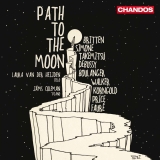Das Bild The Path to the Moon von Thomas Horton, welches das Album schmückt, war für die Interpreten der, in diesem Fall, weiße Faden für ihre Programmzusammenstellung, da die Werke entweder der lyrische Bezug zur Nacht oder zum Mond bzw. ein mehr tatsächliches Streben zu ihm hin sie vereint. Gleichzeitig kombinieren sie bekannte Stücke mit kaum Gehörtem. Einige Lieder, bei denen das Cello die Singstimme ersetzt garnieren drei Sonaten des zwanzigsten Jahrhunderts.
Bei den Sonaten dürften die von Britten und Debussy geläufig sein, die von George Walker eher weniger. Bei den Liedern sind die Beiträge von Lili Boulanger, Debussy und Fauré sicherlich eher bekannt, das von Korngold und auch die von Price, Simone und Takemitsu dagegen eher zu entdecken.
Walker selber verortete seine Vorbilder bei Debussy, Hindemith und Strawinsky. Anklänge an diese sind bei beachtlicher Originalität der Sonate auch zu hören. Die tonal bleibende Sprache ergibt sich aus europäischen und auch durch sein afroamerikanisches Erbe, also Jazz und Spirituals, gefärbten Elementen.
Takemitsu beispielsweise vertont seinen eigenen Text zu einem ungewohnt charmanten kleinen Lied. ‘Everyone’s Gone to the Moon’ in der Fassung von Nina Simone erschien mit perfektem Timing zu der Apollo 11- Mondlandung.
Laura van der Heijden wurde in England als Tochter niederländisch-schweizerischer Eltern geboren. Mit ihren noch nicht einmal 30 Jahren schafft sie einen großen Raum an souverän gespielten Stücken, abwechselnd keck, wehmütig, lyrisch und auch straff geführt. Dabei zeigt sie eine vorbildliche Intonation und auch, dass sie technisch jede Finesse beherrscht. Was sie nicht tut, sie erliegt nicht der Versuchung, zu temperamentvoll und die Musik mit zu saftigem Ton zu buttern. Mitunter entwickelt sie ihr Spiel sogar etwas spröde.
Das Spiel von Jams Coleman zeigt sich nicht nur technisch herausragend. Mit schäumender Energie bei aller Contenance der Tastenbehandlung geben seine Interpretationen den Werken von dieser Seite hier Energie und Pfiff und erzeugen zusammen mit der Cellistin einen hörenswerten Flug zum Mond, sei es in Gedanken, Träumen oder irgendwie auch real.
The image ‘The Path to the Moon’ by Thomas Horton, which adorns the album, was, in this case, the white thread for the performers’ program compilation, as the works are united either by a lyrical reference to the night or to the moon or a more actual striving towards it. At the same time, they combine well-known pieces with little-heard ones. A few songs, in which the cello replaces the singing voice, garnish three twentieth-century sonatas. Among the sonatas, those by Britten and Debussy are likely to be familiar, those by George Walker rather less so. Among the songs, the contributions by Lili Boulanger, Debussy and Fauré are certainly better known, while those by Korngold and Price, Simone and Takemitsu are more likely to be discovered.
Walker himself located his role models in Debussy, Hindemith and Stravinsky. Echoes of these can also be heard in the sonata’s remarkable originality. The tonal language is derived from European elements and those colored by his African-American heritage, i.e. jazz and spirituals.
Takemitsu, for example, sets his own text to an unusually charming little song. ‘Everyone’s Gone to the Moon’ in the version by Nina Simone was released with perfect timing for the Apollo 11 moon landing.
Laura van der Heijden was born in England to Dutch-Swiss parents. At not even 30 years old, she creates a wide range of confidently played pieces, alternately bold, wistful, lyrical and also tightly conducted. She demonstrates exemplary intonation and also that she has mastered every technical finesse. What she doesn’t do is succumb to the temptation of being too spirited and buttering up the music with too juicy a tone. Sometimes she even develops her playing somewhat brittle.
Jams Coleman’s playing is not only technically outstanding. With effervescent energy and all the composure of the keyboard treatment, his interpretations give the works from this side energy and zing and, together with the cellist, create a flight to the moon worth listening to, be it in thoughts, dreams or somehow also real.
























